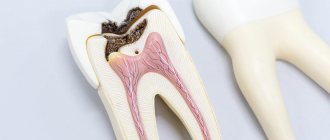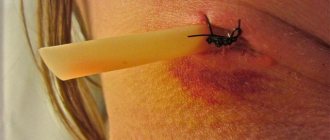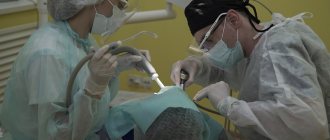- What is a gum former: photo
- What happens after a healing abutment is installed?
- Why does my gum hurt after inserting a gum former?
- The gum former fell out: what to do
- How long to wear
- Gum former: how long does it take to heal?
- How to place a gum former
- Possible complications
- Is it possible to do without a gum former?
- What manufacturers are there?
Dental implantation is one of the most modern and effective methods of orthopedic dentistry. It allows you to restore the integrity of the dentition, correct aesthetic defects and restore the functionality of the dental system. The essence of the procedure is to perform an operation with the installation of an implant, onto which a prosthesis is subsequently attached. Some patients still believe that implantation is an expensive service that is not available to many people. Nowadays it is possible to purchase all consumables at an affordable price; everyone can restore long-missing teeth and restore an attractive appearance to their smile.
Patients have many questions regarding the specifics of implantation, what stages it consists of, etc. An artificial tooth consists of several important elements; in addition to the titanium root, other products are involved in its formation. For example, a gum former device, little is known about it, but without it it is impossible to perform an operation. Today we decided to answer the most common questions about this product, why it is needed at all, what it looks like and what it consists of.
The absence of one or more teeth is a problem that every person can face. The patient almost immediately contacts the dentist for help when a defect occurs on the front part of the dentition, because he is noticeable to others, and he will no longer be able to simply smile. In the event that a molar is lost, which may not be visible, then treatment is postponed until later. Delay is fraught with serious consequences, which makes it difficult to carry out high-quality prosthetics.
The specialists of the A-medic clinic are often asked the following questions regarding the installation and care of the gum former. We answer the most popular and useful of them.
What is a gum former: photo
Many sites that describe the step-by-step process of implantation often do not mention this element, because it is often confused with an abutment, which is a serious mistake. You can look at what a gum former looks like on the Internet or ask your doctor to show it to you. The procedure does not take much time; after the implant is implanted, this structure is installed on it. Then the doctor sutures the wounds, but the former must remain on top of the gingival contour. It is made from special metals, usually titanium, which makes it hypoallergenic and has a low risk of rejection. Titanium alloy is corrosion-resistant and lightweight, it does not load the implant. Its size directly depends on the type of tooth being restored. The main purpose of this device is the formation of soft tissue around the titanium root, so that later the connection between the prosthesis and the gums looks natural and aesthetically pleasing. After its use, it acquires the desired density and volume.
WHAT ARE THE SIGNS OF GUM RECESSION?
Recession (recession) of the gums is accompanied by various symptoms. During recession, the gums become shorter, gradually exposing the roots of the teeth. Therefore, one of the first symptoms of gum recession is increased tooth sensitivity. At the same time, the teeth look longer, and there is a small groove at the edge of the gum, where it comes into contact with the tooth.
Even with these signs, you can't be sure if you have gum recession. To ensure early detection and treatment of gum disease, visit your dentist regularly. It is especially important to detect gum recession in the early stages, since timely treatment is the only way to prevent further development of the disease.
What happens after the healing abutment is installed?
In order for artificial teeth to serve you for many years, you need to approach the implantation process with attention to every detail. The specialists of the A-medic clinic follow all stages of the operation; manipulations are carried out under anesthesia, which ensures comfort and painlessness. Dental restoration using the implantation method occurs in stages; after preparing the oral cavity, the doctor proceeds to the main part. Having fixed the implant in the jawbone, the implantologist screws the gum former into the titanium root. Depending on the chosen implantation method, this stage can be carried out immediately after installation of the implant (single-stage technology) or after some time, when the structure has taken root (two-stage method). Thanks to this element, periodontal tissues acquire a natural appearance and fit tightly to the prosthesis. After a tooth falls out, the bone in its place does not receive any load and begins to atrophy and the soft tissues sag, lose their elasticity, and the gums, after the former, restore their original shape.
Reasons to contact ICDI ROOTT
- The clinic uses unique methods of implantation, bone and gingivoplasty.
- The center is a member of the European organization of dentists Open Dental Community, which means it has access to new developments and methods
- The clinic's doctors have extensive experience working with bone and soft tissue plastic surgery.
- The clinic performs operations on patients who were refused elsewhere due to contraindications.
- ROOT is a multidisciplinary clinic - all services are provided in one place.
- The clinic uses an attractive financial policy, which makes the cost of services ultimately lower than the Moscow average.
- The clinic pays special attention to the safety of treatment through multi-level sterilization.
Why do my gums hurt after inserting a gum former?
Very often, patients come to the clinic after surgery with a complaint of pain. Should I panic in this case and immediately call a doctor? To answer this question, you need to determine the cause of your anxiety. Before starting the operation, the doctor gives the patient an injection with an anesthetic, so the patient does not feel pain during the entire process. When the anesthesia wears off, pain may occur and continue for several days after implantation. This is quite normal, while the soft tissues are healing and your body is adapting, you may be bothered by this symptom. If the pain does not go away within a week and only intensifies, causing you discomfort, then you should urgently seek help from a doctor. Monitor your condition carefully; some changes may indicate the development of complications. Based on this, we can conclude that if your gums hurt after installing a gum former, then you should not immediately sound the alarm, assess your condition and how long the pain lasts. If complaints arise immediately after the end of anesthesia, then you should wait a few days. The discomfort will either pass or begin to bother you with renewed vigor, in which case you should contact your doctor.
The gum former fell out: what to do?
It is also possible that the former becomes unscrewed and falls out of the implant. This may occur due to a loose fit of the element to the titanium root. This happens when the surgeon secured the implant too deep into the bone, and bone tissue grew on it, making it impossible to secure the former tightly. To correct this deficiency, you need to visit a doctor. When the gum former has already fallen out, the first thing you should do is carefully screw it into place and make an appointment with the dentist. Without a plug for a long time, the hole may become overgrown.
How long to wear?
Typically, the process of forming the gingival contour lasts from 2 to 4 weeks; this all happens individually for each person. Therefore, to answer the question: how long can you walk with a gum former? – we can answer that it must be used until the formation of uniform soft tissue edges is completely completed. Your healthcare provider will let you know when to replace the element and secure the abutment. Under no circumstances should you ignore the specialist’s request and continue to wear the gum former.
Gum former: how long does it take to heal?
When implanting a gum former, how long it takes for periodontal tissue to heal depends on several factors:
- patient compliance with recommendations;
- location of prosthetics, on the upper or lower jaw, type of tooth;
- type of implant.
The formation of the gingival margin is not a quick process; in order to get an excellent result, it is necessary to regularly care for the oral cavity and follow the doctor’s instructions until the process of soft tissue regeneration is completed. If the gum does not heal, and its recovery is accompanied by discomfort and complications, then it is necessary to consult with your doctor. You should not try to eliminate painful symptoms on your own; even mild discomfort may indicate the development of inflammation. Because of this, dental implantation will have to be postponed indefinitely.
How to place a gum former?
There are several options for implantation; when it is necessary to immediately restore a newly extracted tooth, it is more advisable to use a one-stage technique; if there is no urgency, then the doctor can suggest a classical technology - a two-stage one. Let's take a closer look at how the gum former is installed in these two methods.
During two-stage implantation, the specialist performs the following actions:
- He administers anesthesia, dissects the gums, and uses a special tool to form a bed for the implant.
- He then inserts a titanium screw into the bone, attaches a plug to it, and sutures the wound.
- After the surgical stage, a period of 3-6 months begins, during which the process of osseointegration takes place. That is, during this time the implant must fuse with the bone and be securely fixed in it.
- After the orthopedic system has successfully taken root, the doctor proceeds to the next stage. The gum is cut and the former is screwed into the implant.
- After a few weeks, this element is removed and an abutment is installed in its place, after which a prosthesis, previously made according to individual casts of the patient’s jaw, is fixed onto it.
When carrying out one-stage implantation, the process of tooth restoration goes much faster, this is the main difference between these two methods from each other. The algorithm of actions is as follows:
- The implantologist cuts the gum, forms a bed and installs the implant together without a former. To prevent the defect from being noticeable, the patient is given a temporary crown; after a few months it will be replaced with a permanent one. In this case, the gums grow naturally around the prosthesis, thereby restoring the aesthetics of the dentition.
Many specialists insist on the use of a gum former, especially in cases where the patient experiences subsidence or loss of periodontal tissue.
Methods
The surgical method is chosen by the doctor based on the gum parameters, width and thickness. Plastic surgery is performed using:
- using your own tissues from the intervention area;
- transplantation of a donor flap from the hard palate;
- application of collagen matrices or membranes.
Membranes are a progressive method of restoration. It differs from others in its high predictability, minimally invasiveness and short rehabilitation period.
Possible complications
Periodontal tissues do not always heal successfully and quickly around the gum former; complications are possible and no one is immune from them. The doctor’s experience, compliance with sterile conditions during implantation and proper care will reduce the risk of unpleasant consequences after the installation of this element.
After surgery, the patient may experience the following complications:
- Edema. Very often, patients are bothered by this symptom, in which case the doctor should reassure you and explain that the swelling will subside in a few days. This is a normal phenomenon, this is how our body reacts to surgery. However, it is worth paying attention to this problem if the swelling after installing the gum former does not go away within a week. This may be due to the fact that the design compresses soft tissues, then it needs to be replaced with another one.
- Bleeding. This sign is also not alarming; usually bleeding after the installation of a gum former appears in people with a low level of blood clotting. The doctor should warn the patient about the possible consequences and, if necessary, prescribe healing medications.
- Pain. If you are bothered by unpleasant and even painful sensations in the neck and throat for a long time after surgery, then you should pay attention to the quality of hygiene. Lack of thorough and regular oral care and an established system can cause the development of this complication. But remember that in the first 2-3 days after surgery, pain at the site where the former is screwed in is normal. If the pain does not disappear, you should seek help from a doctor.
- Allergy. It is also possible that a patient develops an allergic reaction to the material used in prosthetics or to anesthetic drugs. This may happen due to a specialist, because... At the stage of preparation for implantation, he is obliged to find out if the patient has an allergy; in case of an unclear situation, a special test is carried out.
We have listed the main complications that may arise in the postoperative period. As we see, some of them are a consequence of surgical intervention and go away on their own within a few days. But do not forget to monitor your condition and follow the rules of care; when alarming symptoms have been bothering you for more than 5-6 days, you need to urgently consult a doctor.
Recovery period - healing time, recommendations
After surgery, follow your doctor's recommendations:
- use a protective mouth guard to prevent damage to the surgical site;
- do not eat food during the first 5-10 hours , you can drink water after a couple of hours;
- don't smoke for 3 days;
- stick to a diet - take warm lean foods;
- carry out thorough hygiene - cleaning 2-3 times a day , it is not recommended to touch the surgical site with a brush, antiseptic drugs are used;
- take prescribed antibacterial drugs;
- limit physical activity.
The rehabilitation period depends on the volume of intervention and the chosen surgical method. On average, gums heal in 10-14 days.
Is it possible to do without a gum former?
Why is a gum former needed, and is it possible not to use it at all during implantation? This is the question asked by all patients who have been involved in dental restoration. This element is required when carrying out the classical implantation method; it allows you to correctly form the correct gingival contour so that the artificial tooth looks natural and aesthetically pleasing. It can be fixed immediately after implantation or after the process of osseointegration has taken place. When a patient chooses a one-stage implantation technology, usually the stage of installing a gum former is skipped and a crown is immediately attached to the titanium root. But in some cases, when the installation of the prosthesis is delayed for several days, the doctor may install a gum former to preserve the gum contour.
Contraindications
Contraindications for plastic surgery are the same as for implantation. They are divided into relative and absolute. New methods of surgical intervention and materials make it possible to reduce the list of conditions for which gingivoplasty is not recommended. Even if the patient has systemic diseases, only a doctor is able to assess all the risks and make a decision on whether to perform surgery.
Relative
the procedure can be carried out with extreme caution
- Inflammation in the oral cavity;
- exacerbation of chronic diseases;
- caries on neighboring teeth;
- dental plaque and tartar.
Absolute
the procedure is strictly prohibited
- Diseases that interfere with blood clotting;
- chemotherapy;
- uncompensated diabetes.
What manufacturers are there?
All orthopedic systems can be divided into several classes: premium, business and economy. Gum formers are divided according to the same principle; they are manufactured by the same companies that produce implants. The cost of designs from different brands can vary significantly; usually the doctor tries to select all the necessary components from one company; working with them is much easier and simpler.
Gum former Straumann (Switzerland), Astra Tech (Sweden), Nobel (USA) are premium products.
Products of the Xive brand (Germany) can be classified as business class designs. Gum former osstem (South Korea), Bicon (USA), MIS (Israel) - economy class systems.
When choosing the necessary elements for implantation, the specialists of the A-medic clinic take into account the wishes of the patients and their financial capabilities. We do not impose expensive goods, first of all, thinking about you.











